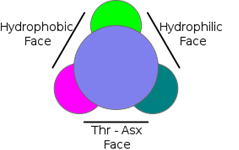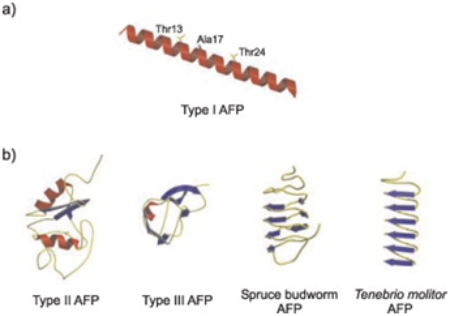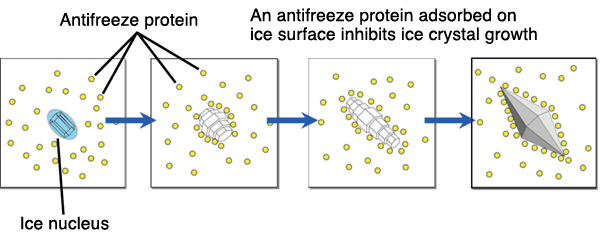Sandbox Reserved 1235
From Proteopedia
| This Sandbox is Reserved from Jan 17 through June 31, 2017 for use in the course Biochemistry II taught by Jason Telford at the Maryville University, St. Louis, USA. This reservation includes Sandbox Reserved 1225 through Sandbox Reserved 1244. |
To get started:
More help: Help:Editing |
Contents |
Antifreeze protein 1
Function
The function of this protein allows fish to constrain the process of recrystalization of water as fishes swim to colder climates , for example like the winter flounder migrating to the northern pole.The protein is secreted by the liver into the blood. Although recently research has shown that the Anti freeze protein isoforms are produced near areas like the skin, scales, fin, or gills in order to become a defense response to the ice propagation.[1] The molecule is found in many other fish as well that migrate to colder climates such as the shorthorn sculpin, and longhorn sculpin. The function is to depress freezing temperature in order to stop the process of recrystallization to occur.[2] recrystallization is When water begins to freeze, many small crystals form, but then a few small crystals dominate and grow larger and larger, stealing water molecules from the surrounding small crystals. Thus making it manageable for fishes like the winter flounder to swim in colder climates.[3]
|
Disease/Mutations
Mutations were studied by replacing the Thr residue of the alpha helix with Valine which in the end still preserved some activity of the hydrogen bonding needed for the anifreeze activity. Another mutation was made to residue adjacent to the Thr-rich face, which was the Ala17 residue. The Ala17 was replaced with Leucine, and this led to the ceased functionality of all antifreeze activity. This this led to the researches to think that the ice binding face of the Antifreeze protein would most likely need Ala17, Ala21,Thr13, and all equivalent residues at the 11-amino acid intervals.[7]
Relevance
The relevance of Antifreeze protein 1 is allowing fish to avoid freezing through halting the growth of the ice and lowering the freezing point.[8] The evidence of convergent evolution is shown through the various forms of Antifreeze proteins. There are proteins that have the same function. All of these are small proteins with threonine and to binds to the ice crystal . These proteins are used in organisms from pout, white flounder, insects, yellow mealworm beetle, spruce budworm moth, and the snow fleas.
Structure
This version of AFP could be recorded as the best documented, for it is the first to have three-dimensional structure determined. it is about 3.3 to 4.5 k Daltons in size. its structure consists of single, long, amphipathic alpha helix. The three dimensional structure consists of three faces: a hydrophobic face, a hydrophilic face, and a Thr-Asx face [9]
--Syed Rahman 09:51, 12 March 2017 (IST)
References
- ↑ http://annualreviews.org/doi/abs/10.1146/annurev.physiol.63.1.359
- ↑ https://www.ncbi.nlm.nih.gov/pubmed/11181960
- ↑ https://pdb101.rcsb.org/motm/120
- ↑ https://en.wikipedia.org/wiki/Antifreeze_protein
- ↑ http://2011.igem.org/Team:KULeuven/Afp
- ↑ http://amazingbiotech.blogspot.com/2014/02/antifreeze-proteins.html
- ↑ https://www.ncbi.nlm.nih.gov/pmc/articles/PMC1301645/pdf/11509380.pdf
- ↑ http://annualreviews.org/doi/abs/10.1146/annurev.physiol.63.1.359
- ↑ http://www.fasebj.org/content/4/8/2460.short



